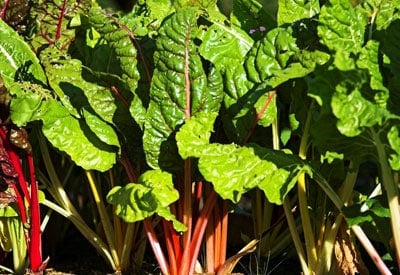This big, leafy cousin to beets comes in a dazzling array of colors — from bright yellow to purple – and is a beautiful addition to edible landscapes and home vegetable gardens across the country. Organic gardeners growing Swiss chard from seed are rewarded with its succulent, mild-flavored leaves that can be eaten raw or cooked like spinach.
Sow directly in the garden before the last frost and make successive plantings — unlike spinach, Swiss chard (Beta vulgaris subsp. vulgaris), a member of the beet family, is heat tolerant as well as cold tolerant. Heavily mulched, it will survive winters in milder climates. Does well in pots too!
Loaded with health benefits, this amazing superfood is an excellent source of vitamins A, C and K, as well as minerals like iron, magnesium, copper and potassium. Swiss chard is virtually fat-free, making it a heart-healthy choice, and contains significant amounts of dietary fiber. Plus, like other leafy greens, it is chock-full of antioxidants and many other disease-fighting properties.
Fun fact: Chard is one of the food crops being grown by astronauts aboard the International Space Station. It was selected for its high nutrient profile, compact habit and ease of growth.

FREE SHIPPING!
Swiss Chard Seeds
This big, leafy cousin to beets comes in a dazzling array of brilliant colors.
View allChoose from a large selection of heirloom Swiss chard seeds available at Planet Natural. Planting instructions are included with each packet and shipping is FREE!
Quick Guide: Planting, Growing & Harvesting Swiss Chard
- Productive spring through fall
- Look for varieties with brightly-colored stems
- Direct seed 2-4 weeks before last frost into nutrient-rich, well-drained soil; water regularly
- Harvest 50-65 days after planting seeds by cutting outer leaves ½ in. above the ground
- Very few pests, but watch for flea beetles
Site Preparation
Swiss chard requires full sun and regular water and should be planted in rich, loose soil. Before planting, work in 10-15 pounds of organic compost per 100 sq. ft. to a depth of 8 inches. Work the soil thoroughly, taking care to break up any large clumps. Rocks should be removed from the planting area.
Add a source of organic nitrogen, such as blood meal or alfalfa meal to develop large, deep colored leaves. Foliar applications with an all-purpose organic fertilizers and liquid kelp 2-3 times during the gardening season will boost production.
How to Plant
Sow seeds directly into the garden two to four weeks before the last expected frost. Plant seeds 1/2 inch deep and 1-3 inches apart. Thin rows as plants mature and eat the tender shoots in salads. Chard is prolific and can tolerate mild frosts and warm temperatures.

Harvesting and Storage
Harvest Swiss chard outer leaves 1/2 inch above the ground as plants mature (5-6 inches tall) and new leaves will form in the center of the plant. Continue harvest until plants bolt in late summer. Save seed for future crops. Chard matures in 50-65 days from seed.
For best flavor, pick in the early morning, rinse and eat fresh, or refrigerate immediately after harvest. Store, loosely packed in plastic bags, in the vegetable crisper.
Insect & Disease Problems
Insects are not commonly found on Swiss chard, but keep an eye out for flea beetles early in the season. They are small (1/10 inch long), shiny, dark brown or black beetles that damage plants by chewing numerous small holes in the leaves. Occasional aphids may attack, however this will typically occur later in the summer when the vegetable turns slightly bitter and is less appealing.
Seed Saving Instructions
Biennial. Varieties must be separated by 1/2 mile when going to seed. Will overwinter in mild climates if well mulched. In northern climates, trim leaves to 2 inches and store roots in sawdust or sand in a root cellar. Roots will store 4-6 months at 32-40˚F. Replant in the spring and harvest seed heads when dry.











